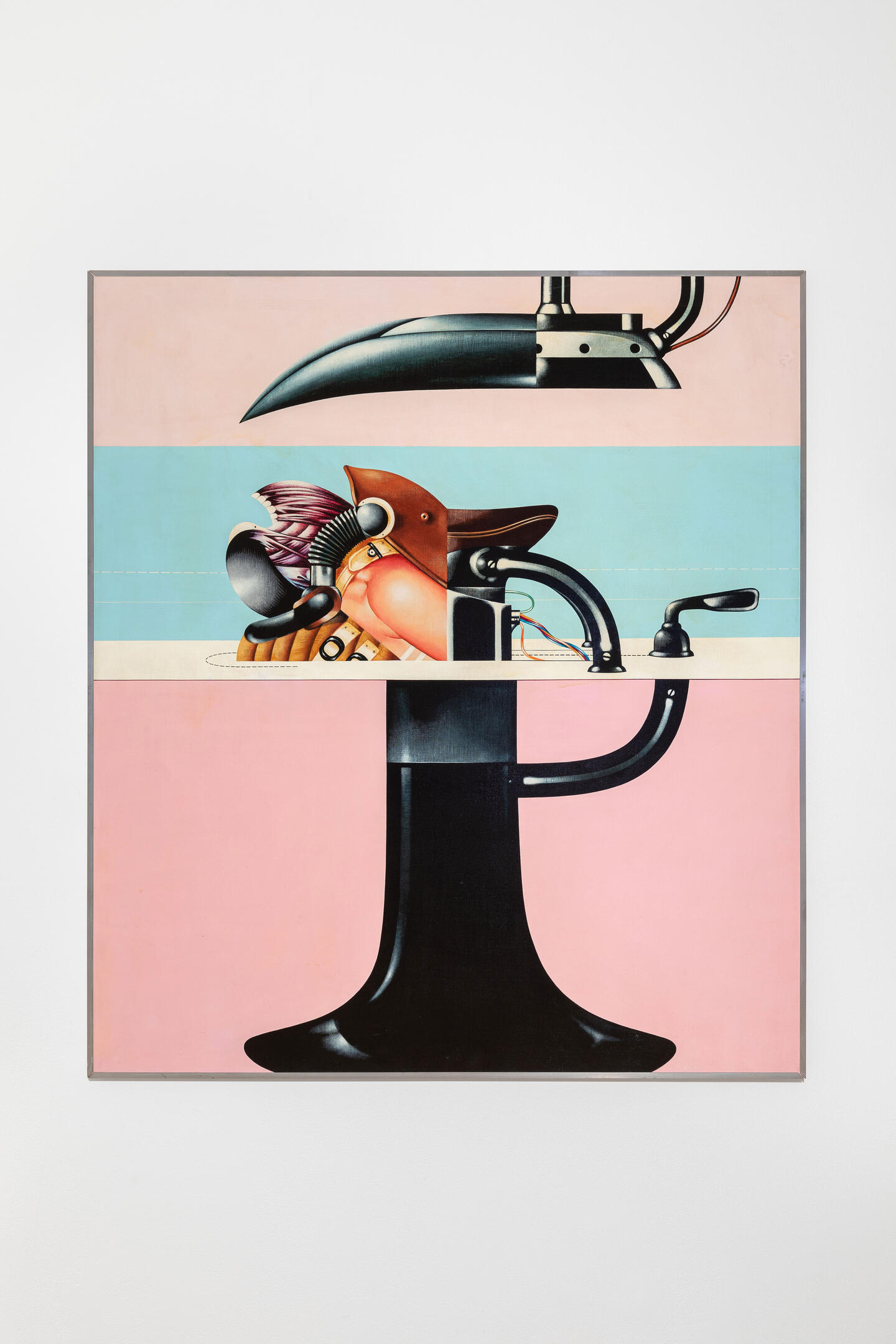Sergio Sarri's Robotization of the Human Body
At Fitzpatrick Gallery, Paris, the artist's overdue retrospective underlies humanity’s compulsive attraction to its technological creations
At Fitzpatrick Gallery, Paris, the artist's overdue retrospective underlies humanity’s compulsive attraction to its technological creations

‘By the late 20th century, our time, a mythic time, we are all chimeras, theorized and fabricated hybrids of machine and organism; in short, we are cyborgs,’ wrote Donna Haraway in her 1985 essay ‘A Cyborg Manifesto’. For Haraway, this merging of man and machine offered the possibility of an end to patriarchal binary thought but, for Sergio Sarri, whose solo exhibition ‘Paintings & Works on Paper: 1971 – 2021’ is currently on view at Fitzpatrick Gallery, Paris, there is no such utopia in sight. Spread over two floors, the Italian painter’s small but dense retrospective, organised in collaboration with Octagon, Milan, depicts a world in which the complex power relations between man and machine are palpable.

Against a background of alternating blue and pink bands, the large-scale acrylic painting Grande Tavolo d’Analisi II (Large Analysis Table II, 1971) depicts an inhospitable amalgam of padded material, tubes, straps, body parts and muscles inserted between two fragments of industrial-type machinery. The precision of the shapes combined with a hyper-realistic colour treatment brings out the materiality of each object, such as sections of glossy black paint that suggest the coldness and polish of metal. In places, the mesh of the canvas even takes on the characteristics of the painted motifs, like the texture of skin in Grande Tavolo d’Analisi (Large Analysis Table, 1971–72). This pictorial sharpness only accentuates the underlying sensuality of the entangled monstrous forms, which combine the darkness of H.G. Geiger’s biomechanical creations with the candy colours of Tom Wesselmann’s stylized pop art still lifes.

On the first floor, various groups of works showcase Sarri’s interest in technology and progress, which culminated in the creation, from the late 1970s onwards, of paintings resembling posters for science-fiction films. Il Grande Robot (The Large Robot, 1979), for instance, clearly refers to Futura, the android in Fritz Lang’s 1927 film Metropolis. At the top of the stairs, four paintings dating from 1973 and 1974 mix representations of what look like scientific analysis grids with apparently dangerous yet oddly sexual high-tech tools. At first glance, the grids seem to have the function of assessing anatomical proportions with vector lines, like those of a monkey and a man in Attrezzo Calcolatore (Calculating Tool, 1973). But, on closer inspection, the lines drawn between points on the body and the edge of the grid are more reminiscent of bondage ropes, hinting at a sadomasochistic, fetishist undercurrent. Through this representation of submission and evocation of pain, Sarri uncovers the friction and interdependence that exist between humans and their technological creations.

In the next group of works, Sarri plays with the ambiguity between reality and fiction by incorporating materials into his canvases. For instance, the plastic wire, aluminium strips and padded synthetic leather that enclose the image of a body suspended from ropes in Fase 4, esecuzione (Phase 4, Execution, 1975) lend the work an abstract, sculptural quality. Sensual and expressive, glossy and opaque, these material elements heighten the realism of the scene and, in so doing, increase the viewer’s empathy towards the subject, whose fate seemingly rests in the hands of the machines that bind him. Ultimately, this work manifests the threat to life that underlies humanity’s compulsive attraction to its technological creations. In Sarri’s later paintings – from Il Grande Robot on – the robotization of the human body becomes increasingly evident, in line with Haraway’s thinking: only by building awareness of oppression is it possible to achieve liberation.
Sergio Sarri’s ‘Paintings & Works on Paper: 1971 – 2021’ is on view at Fitzpatrick Gallery, Paris, until 26 March 2022.
Main image: Sergio Sarri, Untitled, 1983, acrylic on canvas, 80 × 75 cm. Courtesy: the artist, Octagon, Milan, and Fitzpatrick Gallery, Paris




















